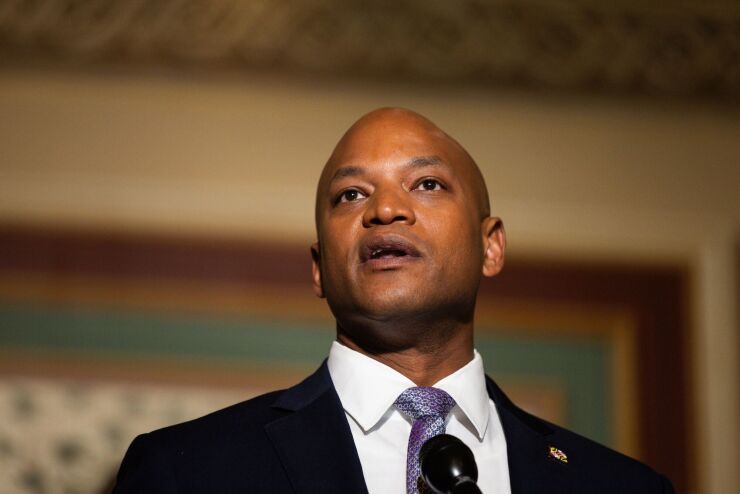Moody’s changes outlook on Maryland’s Aaa rating to negative
3 min read

On Tuesday, Moody’s changed its outlook on Maryland’s credit rating to negative from stable due to a depletion of the state’s general fund surplus, while affirming the state’s issuer and general obligation bond ratings at Aaa.
The Maryland State Treasurer’s office isn’t showing a lot of concern.
“After hosting a successful briefing with all three ratings agencies for the first time in more than a decade, Maryland has once again received a AAA bond rating,” said spokesperson Shareese Nice.
Bloomberg News
“Looking ahead, we are confident that the General Assembly and administration will successfully navigate any challenges just as we have done in the past.”
The rating action comes ahead of Maryland’s plans to sell $1.2 billion competitively Wednesday, in a deal slated to come in four auctions, including a taxable tranche, according to The Bond Buyer’s competitive
Moody’s is eyeing an area of concern in Maryland that is vexing municipalities across the country, the downslope of stimulus-fattened rainy day funds.
Per Moody’s, “The outlook revision was driven by expected structural imbalances and planned depletion of General Fund surplus and budgetary reserves by about 60% from fiscal 2023 through fiscal 2025, which threatens to undermine performance relative to peers.”
Negatives eating away at the reserves include escalating expenditures in education and healthcare, along with retirement benefit liabilities. Spending cuts or new taxes appear as unpopular antidotes.
Moody’s also cites the collapse of the Francis Scott Key bridge after
Both Fitch Ratings and S&P Global Ratings kept stable outlooks when they affirmed Maryland’s triple-A rating ahead of next week’s deal.
“Maryland’s ‘AAA’ IDR and GO rating reflect its broad, diverse and wealthy economy, strong and forward-looking fiscal management, and broad budgetary flexibility despite the challenges posed by increasing medium-term obligations. Liabilities are elevated for a state but are carefully managed and moderate relative to the economic resource base,” Fitch said.
Fitch also identifies education funding and retiree benefits as possible problem areas.
Per S&P, “The state has a long history of proactive budget management to maintain adequate reserves and reduce expenditures when needed, which we expect will continue. However, our view of long-term risks to the state’s credit quality includes pressures on future structural budgetary balance with expected growth in state school spending and managing capital needs within its moderately high debt burden.”
According to the National Association of State Budget Officers, Gov. Wes Moore’s administration passed its $63.1 billion budget on May 16 which was a decrease of $1.1 billion or 1.8% from last year’s budget.
General fund appropriations dropped $1.5 billion, or 5.3%. The March 2024 revenue forecast is estimating $24.9 billion in general fund revenues for fiscal 2025, an increase of 1.8%. The estimated general fund cash balance is $109.7 million for the end of fiscal 2025 with a rainy-day fund balance of $2.3 billion.
Pay-fors in the budget include a .75 cent fee on ride hailing services, a rise in vehicle registration fees and surcharges on electric vehicles, a move that many states are making to supplant falling gas tax revenues.
Cigarettes went up $1.25 cents a pack to pay $91 million towards the education investments that are worrying the credit rating agencies.







